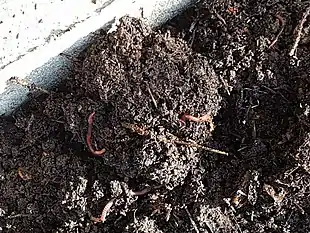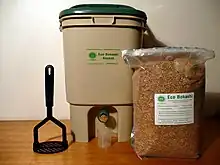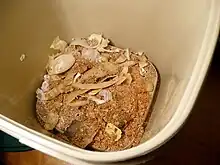
Bokashi is a process that converts food waste and similar organic matter into a soil amendment which adds nutrients and improves soil texture. It differs from traditional composting methods in several respects. The most important are:
- The input matter is fermented by specialist bacteria, not decomposed.
- The fermented matter is fed directly to field or garden soil, without requiring further time to mature.
- As a result, virtually all input carbon, energy and nutrients enter the soil food web, having been neither emitted in greenhouse gases and heat nor leached out.
Other names attributed to this process include bokashi composting, bokashi fermentation and fermented composting.
Nomenclature
The name bokashi is transliterated from spoken Japanese (ぼかし). However, Japanese-English dictionaries give the word an older artistic meaning: "shading or gradation" of images – especially applied to woodblock prints.[1][2] This later extended to mean pixellation or fogging in censored photographs. Therefore, its application to fermented organic matter is of uncertain origin; if both uses are related, unifying concepts may be "alteration" or "fading away".
Bokashi as a food waste process is borrowed in many other languages. As a noun, it has various meanings depending on context, in particular the process itself, the inoculant and the fermented output. This variety can lead to confusion. As an adjective, it qualifies any related noun, such as bokashi bin (a household fermentation vessel), bokashi soil (after adding the preserve), and even bokashi composting – a contradiction in terms.
Process

The basic stages of the process are:
- Organic matter is inoculated with Lactobacilli. These will convert a fraction of the carbohydrates in the input to lactic acid by homolactic fermentation.[3]
- Fermented anaerobically (more precisely, microaerobically)[4] for a few weeks at typical room temperatures in an airtight vessel, the organic matter is preserved by the acid, in a process closely related to the making of some fermented foods and silage. The preserve is normally applied to soil when ready, or can be stored unopened for later use.
- The preserve is mixed into soil that has naturally occurring micro-organisms.
- When water is present (as in the preserve itself or in the soil) the lactic acid progressively dissociates by losing protons to become lactate – the acid's conjugate base or ion salt.[5] Lactate is a fundamental energy carrier in biological processes. It can pass through cell membranes and almost all living organisms have the enzyme lactate dehydrogenase to convert it to pyruvate for energy production.
- Suffused with lactate, the preserve is readily consumed by the indigenous soil life, primarily the bacteria, 'disappearing' within a very few weeks at normal temperatures. Earthworm action is typically prominent as bacteria are themselves consumed, such that the amended soil acquires a texture associated with vermicompost.
Characteristics
Accepted inputs

The process is typically applied to food waste from households, workplaces and catering establishments, because such waste normally holds a good proportion of carbohydrates. It is applied to other organic waste by supplementing carbohydrates and hence lactic acid production. Recipes for large scale bokashi in horticulture often include rice, and molasses or sugar.[6][7] Any carbohydrate-poor waste stream would benefit from this.
Homolactic fermentation can process significantly more kinds of food waste than home composting. Even items considered problematic in traditional composting, such as cooked leftovers, meat and skin, fat, cheese and citrus waste are, in effect, pre-digested to enable soil life to consume them. Large pieces may take longer to ferment and concave surfaces may trap air, in which cases cutting down is advised in support literature.[8]
Pieces of input are discarded if they are already badly rotten, or show green or black mould. These harbour putrefying organisms which may overwhelm the fermentation.
Emissions
Carbon, gases and energy
Homolactic fermentation and similar anaerobic fermentation pathways in general provide a very small amount of energy to the cell compared to the aerobic process. In homolactic fermentation, 2 ATP molecules are made when one glucose molecule (produced by digesting complex carbohydrates) is converted to 2 lactic acid molecules,[9] only 1⁄15 of what aerobic respiration provides.[10] The process will also halt before all available carbohydrates are used, as the acidity ends up inhibiting all bacteria. As a result, a bokashi bucket barely heats up and remains at ambient temperature.[11]
As a waste processing technique, bokashi is notable in that minimal loss of mass in the form of offgassing happens. Compost, which is aerobic, "burns up" much of the carbon into carbon dioxide to sustain the metabolism of microbes as it matures. Biogas production does not burn the carbon, but the bacterial culture is optimized to extract the carbon in the form of methane – a potent greenhouse gas and a useful fuel. In addition, compost can also lose the key plant nutrient nitrogen (in the potent greenhouse gas nitrous oxide and in ammonia), while bokashi almost does not.[11]
Runoff
When fermentation begins, physical structures start to break down and release some of the input's water content as a liquid runoff. Over time this constitutes more than 10% of the input by weight. The quantity varies with the input: for example cucumber and melon flesh lead to a noticeable increase.
The liquid leaches out a valuable fraction of proteins, nutrients and lactic acid. To recover them, and to avoid drowning the fermentation, runoff is captured from the fermentation vessel, either through a tap, into a base of absorbent material such as biochar or waste cardboard, or into a lower chamber. The runoff is sometimes called "bokashi tea".
The uses of bokashi tea are not the same as those of "compost tea". It is used most effectively when diluted and sprinkled over a targeted area of soil to feed the soil ecosystem. Dilution makes it less acidic and thus less dangerous to plants. Dilution also causes more acid to convert into lactate which is an attractive food for soil microbes. Other uses are either potentially damaging (e.g. feeding plants with acidic water) or wasteful (e.g. cleaning drains with plant nutrients, feeding plants with nutrients in a form they cannot take up).
Volumes
Household containers ("bokashi bins") typically give a batch size of 5–10 kilograms (11–22 lb). This is accumulated over a few weeks of regular additions. Each regular addition is best accumulated in a caddy, because it is recommended that one opens the bokashi bin no more frequently than once per day to let anaerobic conditions predominate.
In horticultural settings batches can be orders of magnitude greater.[6][11] Silage technology may be usable if it is adapted to capture runoff. An industrial-scale technique mimics the windrows of large-scale composting, except that bokashi windrows are compacted, covered tightly and left undisturbed, all to promote anaerobic conditions. One study suggests that such windrows lose only minor amounts of carbon, energy and nitrogen.[11]
Hygiene
Bokashi is inherently hygienic in the following senses:
- Lactic acid is a strong natural bactericide, with well-known antimicrobial properties.[12] It is an active ingredient of some toilet cleaners.[13] As more is produced, it eventually suppresses even its own makers, the acid-resistant lactobacilli, such that bokashi fermentation eventually slows and stops itself. There is also evidence that mesophilic (ambient temperature) fermentation kills eggs of the Ascaris worm – a parasite of humans – in 14 days.[14]
- The fermentation bin does not release smells when it is closed. A household bin is only opened for a minute or so to add and inoculate input via the lid or to drain runoff via the tap. At these times the user encounters the sour odour of lacto-fermentation (often described as a "pickle") which is much less offensive than the odour of decomposition.[15]
- When closed, an airtight fermentation bin cannot attract insects.
- Bokashi literature claims that scavengers dislike the fermented matter and avoid it in gardens.[16]
Addition to soil
Fermented bokashi is added to a suitable area of soil. The approach usually recommended by suppliers of household bokashi is along the lines of "dig a trench in the soil in your garden, add the waste and cover over."[17]
In practice, regularly finding suitable sites for trenches that will later underlie plants is difficult in an established plot. To address this, an alternative is a 'soil factory'.[18] This is a bounded area of soil into which several loads of bokashi preserve are mixed over time. Amended soil can be taken from it for use elsewhere. It may be of any size. It may be permanently sited or in rotation. It may be enclosed, wire-netted or covered to keep out surface animals. Spent soil or compost, and organic amendments such as biochar may be added, as may non-fermented material, in which case the boundary between bokashi and composting becomes blurred.
A proposed alternative[19] is to homogenise (and potentially dilute) the preserve into a slurry, which is spread on the soil surface. This approach requires energy for homogenisation but, logically from the characteristics set out above, should confer several advantages: thoroughly oxidising the preserve; disturbing no deeper layers, except by increased worm action; being of little use to scavenging animals; applicable to large areas; and, if done repeatedly, able to sustain a more extensive soil ecosystem.
History
The practice of bokashi is believed to have its earliest roots in ancient Korea. This traditional form ferments waste directly in soil, relying on native bacteria and on careful burial for an anaerobic environment. A modernised horticultural method called Korean Natural Farming includes fermentation by indigenous micro-organisms (IM or IMO) harvested locally, but has numerous other elements too. A commercial Japanese bokashi method was developed by Teruo Higa in 1982 under the 'EM' trademark (short for Effective Microorganisms).[20] EM became the best known form of bokashi worldwide, mainly in household use, claiming to have reached over 120 countries.[20]
While none have disputed that EM starts homolactic fermentation and hence produces a soil amendment, other claims have been contested robustly. Controversy relates partly to other uses, such as direct inoculation of soil with EM and direct feeding of EM to animals, and partly to whether the soil amendment's effects are due simply to the energy and nutrient values of the fermented material rather than to particular microorganisms.[21] Arguably, EM's heavy focus on microorganisms has diverted scientific attention away from both the bokashi process as a whole and the particular roles in it of lactic acid, lactate, and soil life above the bacterial level.
Alternative approaches
Some organisms in EM, specifically photosynthetic bacteria and yeast, appear to be logically superfluous, as they will first be suppressed by the dark and anaerobic environment of homolactic fermentation, then killed by its lactic acid. Consequently, practitioners have sought to reduce costs and to widen the scale of operations. Success has been reported with:
- Self-harvested micro-organisms, tested for lacto-fermentation;[22][23]
- Lactobacilli alone, i.e. without other EM micro-organisms.[24] Useful sources include acid whey from yogurt[25] and sauerkraut juice.[26]
- Alternative substrates for inoculant, such as newsprint;[25]
- Home-made airtight fermentation vessels;
- Larger scale than a household, for example a group of small farmers.[27]
- No intentional addition of microbes at all, similar to the original Korean method. The resulting mixture will smell worse as acetic acid, propanoic acid, and butyric acid can form instead of lactic acid (see mixed acid fermentation), but works equally well as soil amendment.[4]
Uses
The main use of bokashi that is described above is to recover value from organic waste by converting it into a soil amendment.
In Europe, food and drink material that is sent to animal feed does not legally constitute waste because it is regarded as 'redistribution.'[28] This may apply to bokashi made from food, because it enters the soil food web, and furthermore is inherently pathogen-free.
A side effect of diverting organic waste to the soil food web is to divert it away from local waste management streams and their associated costs of collection and disposal. To encourage this, for example most UK local authorities subsidise household bokashi starter kits through a National Home Composting Framework.[29]
Another side effect is to increase the organic carbon content of the amended soil. Some of this is a relatively long-term carbon sink – insofar as the soil ecosystem creates humus – and some is temporary for as long as the richer ecosystem is sustained by measures such as permanent planting, no-till cultivation and organic mulch. An example of these measures is seen at the Ferme du Bec Hellouin in France.[23] Bokashi would therefore have potential uses in enabling communities to speed up the conversion of land from chemical to organic horticulture and agriculture, to regenerate degraded soil, and to develop urban and peri-urban horticulture close to the sources of input.
The anti-pathogenic nature of bokashi is applied to sanitation, in particular to the treatment of faeces. Equipment and supplies to treat pet faeces are sold commercially[30] but do not always give prominence to the hygiene risks.[31] Treatment of human faeces for soil amendment has been extensively studied, notably with the use of biochar (a soil improver in its own right) to remove odours and retain nutrients.[32] Social acceptability is a major obstacle, but niche markets such as emergency aid sanitation, outdoor events and temporary workplaces may develop the technology into a disruptive innovation.
See also
References
- ↑ "Tangorin Dictionary". Retrieved 9 January 2019.
- ↑ "Meaning of bokashi in Japanese". RomajiDesu.
- ↑ Yamada, Kengo; Xu, Hui-lian (2000). "Properties and Applications of an Organic Fertilizer Inoculated with Effective Microorganisms". Journal of Crop Production. 3: 255–268. doi:10.1300/J144v03n01_21. S2CID 73574288 – via ResearchGate.
- 1 2 Alattar, MA; Green, TR; Henry, J; Gulca, V; Tizazu, M; Bergstrom, R; Popa, R (June 2012). "Effect of microaerobic fermentation in preprocessing fibrous lignocellulosic materials". Applied Biochemistry and Biotechnology. 167 (4): 909–17. doi:10.1007/s12010-012-9717-5. PMID 22639359. S2CID 13497839.
- ↑ "Lactic acid and Lactate". Lactic Acid. Archived from the original on 19 August 2021. Retrieved 19 Aug 2021.
- 1 2 "Bokashi du Costa Rica – Recette". Alterculteurs. February 2017. Archived from the original on 2019-01-14. Retrieved 5 October 2021.
- ↑ "Honduras – Making Bocashi Fertilizer". Paper Bokashi. January 2011. Retrieved 9 January 2018.
- ↑ "Can I put shells, coffee grounds, egg shells, and large items into my bokashi bin?". Bokashi Living. Retrieved 2020-12-15.
- ↑ AP Biology. Anestis, Mark. 2nd Edition. McGraw-Hill Professional. 2006. ISBN 978-0-07-147630-0. p. 61
- ↑ Rich, P. R. (2003). "The molecular machinery of Keilin's respiratory chain". Biochemical Society Transactions. 31 (Pt 6): 1095–1105. doi:10.1042/BST0311095. PMID 14641005.
- 1 2 3 4 Bosch, Marlou; Hitman, Anke; Hoekstra, Jan Feersma (2016). "Fermentation (Bokashi) versus Composting of Organic Waste Materials: Consequences for Nutrient Losses and CO2 footprint" (PDF). Agriton.nl. Retrieved 17 January 2019.
- ↑ De Vuyst, L.; Vandamme, E.J. (1994). "Antimicrobial Potential of Lactic Acid Bacteria". Bacteriocins of Lactic Acid Bacteria. Boston, MA, USA: Springer. pp. 91–129. doi:10.1007/978-1-4615-2668-1_3. ISBN 978-1-4613-6146-6.
- ↑ "Toilet Duck® Thick Liquid Toilet Bowl Cleaner". SC Johnson. 2019. Retrieved 9 January 2019.
- ↑ Ligocka, A.; Paluszak, Z. (2009). "Effectiveness of different sanitisation technologies on the inactivation of Ascaris suum eggs in organic waste". Bulletin of the Veterinary Institute in Puławy. 53: 641–644.
- ↑ Foxx, D.S. (August 2009). "Can you smell that?". Bokashislope. Retrieved 9 January 2019.
- ↑ Casley, Nikki (August 2015). "Composting without pests". Bokashi Living. Retrieved 9 January 2019.
- ↑ "Using your bokashi bucket". Bokashi Direct. June 2016. Archived from the original on 27 April 2019. Retrieved 9 January 2019.
- ↑ Harlen, Jenny (4 March 2013). "How to make a soil factory". Bokashi World. Retrieved 9 January 2019.
- ↑ Pavlis, Robert (5 November 2017). "Soil Factory Using Bokashi Ferment". Garden Myths.
- 1 2 "The History of Bokashi & How It Works". EM Bokashi Composting. 16 October 2012. Retrieved 9 January 2019.
- ↑ Mayer, J.; et al. (2010). "How effective are 'Effective microorganisms® (EM)' Results from a field study in temperate climate". Applied Soil Ecology. 46 (2): 230–239. doi:10.1016/j.apsoil.2010.08.007.
- ↑ Park, Hoon; DuPonte, Michael W. (August 2008). "How to Cultivate Indigenous Microorganisms". Biotechnology. University of Hawaii. 9: 1–7. hdl:10125/12174.
- 1 2 Hervé-Gruyer, Perrine & Charles (2019). Vivre avec la Terre (in French). Arles: Actes Sud. pp. 261–267. ISBN 9782330119478.
- ↑ "How to Make and Use Your Own Lactobacillus Culture". Dude Grows. 11 January 2017. Retrieved 9 January 2019.
- 1 2 "Paper Bokashi". "Newspaper Bokashi" Blog. 2008. Retrieved 9 January 2019.
- ↑ Factura, H.; Bettendorf, T.; Buzie, C.; Pieplow, H.; Reckin, J.; Otterpohl, R. (May 2010). "Terra Preta sanitation: re-discovered from an ancient Amazonian civilisation – integrating sanitation, bio-waste management and agriculture" (PDF). Water Science & Technology. 61 (10): 2673–9. doi:10.2166/wst.2010.201. PMID 20453341. Archived from the original (PDF) on 2016-09-16. Retrieved 25 August 2016.
- ↑ "Recipe for Regeneration in Honduras". USC Canada. 25 August 2017. Archived from the original on 30 September 2019. Retrieved 9 January 2019.
- ↑ "Digest of Waste and Resource Statistics, 2018 edition". GOV.UK for Department for Environment, Food & Rural Affairs. 24 May 2018. Retrieved 9 January 2019.
- ↑ "The National Home Composting Framework". Straight Ltd (see Partners tab for local authorities). Archived from the original on 18 January 2021. Retrieved 9 January 2019.
- ↑ "Pet use". Bokashi Cycle. Retrieved 13 January 2019.
- ↑ "Dog Poo Wormeries and Composting Cat & Dog Faeces (subheading "Bokashi fermentation of dog and cat faeces")". Carry on Composting. 2014. Archived from the original on 13 January 2019. Retrieved 13 January 2019.
- ↑ Yemaneh, Asrat; Itchon, Gina (2015). Otterpohl, Ralf; et al. (eds.). Terra Preta Sanitation 1 – Background, Principles and Innovations. Deutsche Bundesstiftung Umwelt. pp. 127–132. ISBN 978-3-00-046586-4.